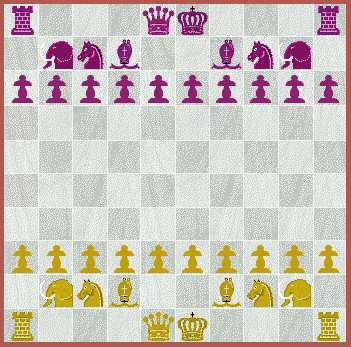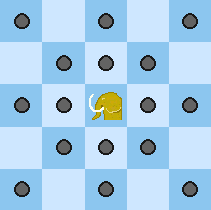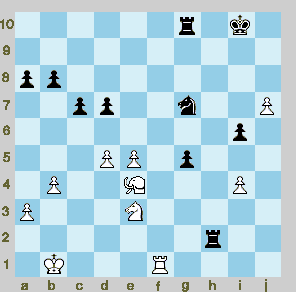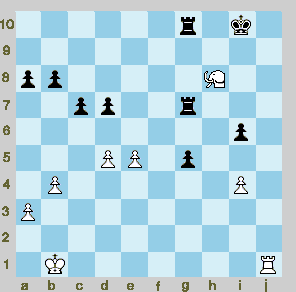

Introduction
The objective in Mastodon Chess is checkmate. The size of the board is 10x10. Pieces move as in orthodox chess, with the exception of the additional piece, the Mastodon. It jumps one or two steps diagonally or orthogonally. Its value is at least a rook. The Mastodon jump complements the jump move of the Knight. A Mastodon, together with a King, can give mate to a lonely King. The pawns move as in orthodox chess, inclusive of the initial double-step and 'en passant'. Castling exists, but the King jumps three squares instead of two. As usual, the Rook ends up beside the King. Promotion rules are the same as in orthodox chess (with the addition of the Mastodon). This variant is an attempt to overcome common problems in big-board variants, namely that they are sometimes too slow or overly technical.
Always give your King a protected position, preferably near the corner. If the Kings are placed on different wings the play is likely to be combative. The Mastodon equals Rook + two Pawns on a standard 8x8 board, but on this big board it has the same value as the Rook, perhaps a little more. Rook and Mastodon cooperate effectively in the attack on the enemy king.
 The Mastodon jumps one
or two steps diagonally
or orthogonally.
The Mastodon jumps one
or two steps diagonally
or orthogonally.
Mastodon Chess is related to Mammoth Chess and Mastodon Chess (8x10), which use the same pieces. The Mastodon piece (also called Mammoth) is not new. In E. V. Greenwood's Renniassance Chess (not misspelt) from 1980, the piece is named Squire. The earliest reference I know is Paulovits's Game, c.1890, where it is called Pasha (cf. The Classified Encyclopedia of Chess Variants). Chess variants featuring big boards have been invented before, most notably Tamerlane Chess, allegedly invented by Timur Lenk, C. Freeling's Grand Chess, and Capablanca's chess, invented by the former world champion.
In Mastodon Chess, unlike in Grand Chess, the castle move is retained. This makes the game more strategical. The idea behind this 10x10 variant is to create a calm strategical game where one doesn't immediately fall prey to some tactical tricks. It is essential to move the pawns on the wings and try to acquire a long-term initiative. The opportunities are better on the wings than in the centre. If White wants to try and create a majority in the centre, to move the bishop pawns (d and g) two steps is probably a good alternative. The Mastodon is a piece which is easily mastered, very suited for the congested environment in a game with many pieces and pawns. Although it is somewhat slow, as soon as it becomes active it is very powerful. It is sometimes better than the Queen in attacks on the enemy King. King + Mastodon wins against King + Bishop or Knight, and draws against King + Queen.
On this big board one would expect that advancing the pawn line and acquiring territory would not be particularly rewarding while the opponent has enough space for maneuvering his pieces anyway. But a spatial advantage leads to much better chances when attacking the enemy king. While the game proceeds many squares in the vicinity of the king will become weak. In the typical case, the party with spatial advantage will have escape routes for his king, but the other party could be in a worse situation, especially if the king is threatened by a Mastodon.
(In alternative variants the following pieces are employed: Kwaggas, Guanacos, Donkeys, or Swedish Cannons (see the downloadable zip-file).)
Examples
 Despite the powerful long range Rooks, the party with the Mastodon often has the upper hand. At a first glance this position looks fine for black, but this example shows how efficient the Mastodon is when utilizing the fact that the enemy King is unprotected. 1.Mg6 Rj2 2.Nf5 Rxj7 3.Nxg7 Rjxg7 4.Mi8+ Kh10 5.Mh8+ Ki10 6.Rj1 and...
Despite the powerful long range Rooks, the party with the Mastodon often has the upper hand. At a first glance this position looks fine for black, but this example shows how efficient the Mastodon is when utilizing the fact that the enemy King is unprotected. 1.Mg6 Rj2 2.Nf5 Rxj7 3.Nxg7 Rjxg7 4.Mi8+ Kh10 5.Mh8+ Ki10 6.Rj1 and...
 …mate follows on j10.
…mate follows on j10.
• You can download my free Mastodon Chess program here (updated 2009-04-28), but you must own the software Zillions of Games to be able to run it.
• Try playing Mastodon Chess by e-mail, against a human opponent, here.
• Don't miss my other chess variants.
© M. Winther 2006